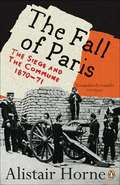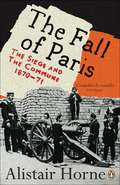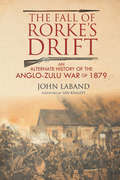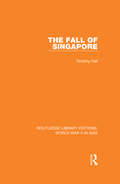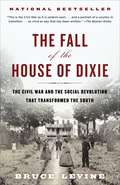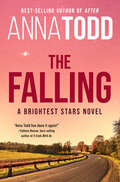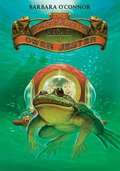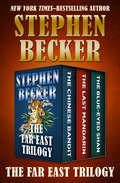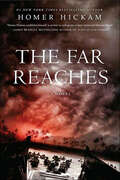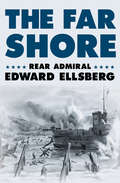- Table View
- List View
The Fall of Malaya and Singapore: Rare Photographs From Wartime Archives (Images of War)
by Jon DiamondIn just 10 weeks from 8 December 1941 to mid February 1942, British and Imperial forces were utterly defeated by the numerically inferior Japanese under General Yamashita.British units fought hard on the Malayan mainland but the Japanese showed greater mobility, cunning and tactical superiority. Morale was badly affected by the loss of HMS Prince of Wales and Repulse to Japanese aircraft on 19 December as they sought out enemy shipping. Panic set in as military and civilians withdrew south to Singapore. Thought to be an impregnable fortress, its defences against land attacks were shockingly deficient. General Percival's leadership was at best uninspired and at worst incompetent.Once the Allied troops withdrew to Singapore it was only a matter of time before surrender became inevitable. To make matters worse reinforcements arrived but only in time to be made POWs.The whole catastrophe is brilliantly described in this highly illustrated book.
The Fall of Paris: The Siege and the Commune 1870-71
by Alistair HorneAlistair Horne's The Fall of Paris: The Siege and the Commune, 1870-71 is the first book of Alistair Horne's trilogy, which includes The Price of Glory and To Lose a Battle and tells the story of the great crises of the rivalry between France and Germany. The collapse of France in 1870 had an overwhelming impact - on Paris, on France and on the rest of the world. People everywhere saw Paris as the centre of Europe and the hub of culture, fashion and invention. But suddenly France, not least to the disbelief of her own citizens, was gripped in the vice of the Prussian armies and forced to surrender on humiliating terms. Almost immediately Paris was convulsed by the savage self-destruction of the newly formed Socialist government, the Commune. In this brilliant study of the Siege of Paris and its aftermath, Alistair Horne researches first-hand accounts left by official observers, private diarists and letter-writers to evoke the high drama of those ten tumultuous months and the spiritual and physical agony that Paris and the Parisians suffered as they lost the Franco-Prussian war.
The Fall of Paris: The Siege and the Commune 1870-71
by Alistair HorneThe collapse of France in 1870 had an overwhelming impact – on Paris, on France and on the rest of the world. People everywhere saw Paris as the centre of Europe and the hub of culture, fashion and invention. Suddenly France, not least to the disbelief of her own citizens, was gripped in the vice of the Iron Chancellor’s armies and forced to surrender on humiliating terms. In this brilliant study of the Siege and its aftermath, Alistair Horne evokes the high drama of those ten fantastic months and the spiritual agony which Paris and the Parisians suffered.The Fall of Paris is the first part of the trilogy including To Lose a Battle and The Price of Glory (already available in Penguin).
The Fall of Rorke's Drift: An Alternate History of the Anglo-Zulu War of 1879
by John LabandFor fans of Harry Turtledove, an alternate history novel in which Zulu forces triumph over the British at Rorke&’s Drift in 1879 and invade Natal. January 1879. The British Empire and the Zulu Kingdom are at war. Lord Carnarvon, Secretary of State for the Colonies, who had successfully brought about federation in Canada in 1867, had believed a similar scheme would work in South Africa. But such plans are rejected by Boer leaders. Lord Chelmsford leads a British military expeditionary force to enter the Zulu Kingdom uninvited. A bloody battle ensues on 22 January 1879 at Isandlwana. The Zulus are the unexpected victors. After that brutal defeat, the British Army are at Rorke&’s Drift on the Buffalo River in Natal Province, South Africa. A few hundred British and colonial troops, led by Lieutenants John Chard of the Royal Engineers and Gonville Bromhead, face the might of the Zulu army of thousands led by Prince Dabulamanzi kaMpande (CORR). Against the odds, the British are victorious, and this defeat marks the end of the Zulu nation&’s dominance of the region. The Defence of Rorke&’s Drift would go down in history as an iconic British Empire Battle and inspired Victorian Britain. Eleven Victoria Crosses were awarded to military personnel. But what if the Zulus had defeated the British at Rorke&’s Drift and invaded Natal? . . . In the first ever alternate history of the Anglo-Zulu War, historian John Laband asks that question. With his vast knowledge of the Anglo-Zulu War, he turns history on its head and offers a tantalizing glimpse of a very different outcome, weaving a compelling, never-before told story of what could have been.
The Fall of Rorke's Drift: An Alternate History of the Anglo-Zulu War of 1879
by John LabandFor fans of Harry Turtledove, an alternate history novel in which Zulu forces triumph over the British at Rorke&’s Drift in 1879 and invade Natal. January 1879. The British Empire and the Zulu Kingdom are at war. Lord Carnarvon, Secretary of State for the Colonies, who had successfully brought about federation in Canada in 1867, had believed a similar scheme would work in South Africa. But such plans are rejected by Boer leaders. Lord Chelmsford leads a British military expeditionary force to enter the Zulu Kingdom uninvited. A bloody battle ensues on 22 January 1879 at Isandlwana. The Zulus are the unexpected victors. After that brutal defeat, the British Army are at Rorke&’s Drift on the Buffalo River in Natal Province, South Africa. A few hundred British and colonial troops, led by Lieutenants John Chard of the Royal Engineers and Gonville Bromhead, face the might of the Zulu army of thousands led by Prince Dabulamanzi kaMpande (CORR). Against the odds, the British are victorious, and this defeat marks the end of the Zulu nation&’s dominance of the region. The Defence of Rorke&’s Drift would go down in history as an iconic British Empire Battle and inspired Victorian Britain. Eleven Victoria Crosses were awarded to military personnel. But what if the Zulus had defeated the British at Rorke&’s Drift and invaded Natal? . . . In the first ever alternate history of the Anglo-Zulu War, historian John Laband asks that question. With his vast knowledge of the Anglo-Zulu War, he turns history on its head and offers a tantalizing glimpse of a very different outcome, weaving a compelling, never-before told story of what could have been.
The Fall of Singapore 1942 (Routledge Library Editions: World War II in Asia)
by Timothy HallSingapore fell to the Japanese on 15 September 1942, but in 1941 Europeans on the island felt still untouched by war, lulled into security by the belief that Singapore was impregnable from the sea. However, the Planning Chief of Imperial Army Headquarters in Tokyo had realised a successful invasion could come from the north, down the Malay peninsula... Requests from less naive members of the allied forces for more men, arms and equipment were not filled. Authorities were unwilling to reveal to the civilian population the true situation. And so through accident or miscalculation, Singapore was totally unable to repel the Japanese attack. This accessible book, illustrated with black and white photos charts the course of these events.
The Fall of the Athenian Empire (A New History of the Peloponnesian War)
by Donald KaganIn the fourth and final volume of his magisterial history of the Peloponnesian War, Donald Kagan examines the period from the destruction of Athens' Sicilian expedition in September of 413 B.C. to the Athenian surrender to Sparta in the spring of 404 B.C. Through his study of this last decade of the war, Kagan evaluates the performance of the Athenian democracy as it faced its most serious challenge. At the same time, Kagan assesses Thucydides' interpretation of the reasons for Athens' defeat and the destruction of the Athenian Empire.
The Fall of the House of Dixie: The Civil War and the Social Revolution That Transformed the South
by Bruce LevineIn this major new history of the Civil War, Bruce Levine tells the riveting story of how that conflict upended the economic, political, and social life of the old South, utterly destroying the Confederacy and the society it represented and defended. Told through the words of the people who lived it, The Fall of the House of Dixie illuminates the way a war undertaken to preserve the status quo became a second American Revolution whose impact on the country was as strong and lasting as that of our first. In 1860 the American South was a vast, wealthy, imposing region where a small minority had amassed great political power and enormous fortunes through a system of forced labor. The South's large population of slaveless whites almost universally supported the basic interests of plantation owners, despite the huge wealth gap that separated them. By the end of 1865 these structures of wealth and power had been shattered. Millions of black people had gained their freedom, many poorer whites had ceased following their wealthy neighbors, and plantation owners were brought to their knees, losing not only their slaves but their political power, their worldview, their very way of life. This sea change was felt nationwide, as the balance of power in Congress, the judiciary, and the presidency shifted dramatically and lastingly toward the North, and the country embarked on a course toward equal rights. Levine captures the many-sided human drama of this story using a huge trove of diaries, letters, newspaper articles, government documents, and more. In The Fall of the House of Dixie, the true stakes of the Civil War become clearer than ever before, as slaves battle for their freedom in the face of brutal reprisals; Abraham Lincoln and his party turn what began as a limited war for the Union into a crusade against slavery by issuing the Emancipation Proclamation; poor southern whites grow increasingly disillusioned with fighting what they have come to see as the plantation owners' war; and the slave owners grow ever more desperate as their beloved social order is destroyed, not just by the Union Army, but also from within. When the smoke clears, not only Dixie but all of American society is changed forever. Brilliantly argued and engrossing, The Fall of the House of Dixie is a sweeping account of the destruction of the old South during the Civil War, offering a fresh perspective on the most colossal struggle in our history and the new world it brought into being.Praise for The Fall of the House of Dixie "This is the Civil War as it is seldom seen. . . . A portrait of a country in transition . . . as vivid as any that has been written."--The Boston Globe "An absorbing social history . . . For readers whose Civil War bibliography runs to standard works by Bruce Catton and James McPherson, [Bruce] Levine's book offers fresh insights."--The Wall Street Journal "More poignantly than any book before, The Fall of the House of Dixie shows how deeply intertwined the Confederacy was with slavery, and how the destruction of both made possible a 'second American revolution' as far-reaching as the first."--David W. Blight, author of American Oracle "Splendidly colorful . . . Levine recounts this tale of Southern institutional rot with the ease and authority born of decades of study."--Kirkus Reviews (starred review) "A deep, rich, and complex analysis of the period surrounding and including the American Civil War."--Publishers Weekly (starred review)
The Fall of the House of Habsburg
by Edward CrankshawHow the Habsburg Dynasty was destroyed as a result of the European wars of the early twentieth century.
The Fall of the Ottomans: The Great War in the Middle East
by Eugene RoganIn 1914 the Ottoman Empire was depleted of men and resources after years of war against Balkan nationalist and Italian forces. But in the aftermath of the assassination in Sarajevo, the powers of Europe were sliding inexorably toward war, and not even the Middle East could escape the vast and enduring consequences of one of the most destructive conflicts in human history. The Great War spelled the end of the Ottomans, unleashing powerful forces that would forever change the face of the Middle East. In The Fall of the Ottomans, award-winning historian Eugene Rogan brings the First World War and its immediate aftermath in the Middle East to vivid life, uncovering the often ignored story of the region’s crucial role in the conflict. Bolstered by German money, arms, and military advisors, the Ottomans took on the Russian, British, and French forces, and tried to provoke Jihad against the Allies in their Muslim colonies. Unlike the static killing fields of the Western Front, the war in the Middle East was fast-moving and unpredictable, with the Turks inflicting decisive defeats on the Entente in Gallipoli, Mesopotamia, and Gaza before the tide of battle turned in the Allies’ favor. The great cities of Baghdad, Jerusalem, and, finally, Damascus fell to invading armies before the Ottomans agreed to an armistice in 1918. The postwar settlement led to the partition of Ottoman lands between the victorious powers, and laid the groundwork for the ongoing conflicts that continue to plague the modern Arab world. A sweeping narrative of battles and political intrigue from Gallipoli to Arabia, The Fall of the Ottomans is essential reading for anyone seeking to understand the Great War and the making of the modern Middle East.
The Fall of the Seleukid Empire, 187–75 BC
by John D. GraingerThird in the trilogy of the ancient Greek dynasty. &“In Grainger&’s account, the fall of the Seleukid is as enlightening as the rise.&”—Minerva Magazine The concluding part of John D Grainger&’s history of the Seleukids traces the tumultuous last century of their empire. In this period, it was riven by dynastic disputes, secessions and rebellions, the religiously inspired insurrection of the Jewish Maccabees, civil war and external invasion from Egypt in the West and the Parthians in the East. By the 80s BC, the empire was disintegrating, internally fractured and squeezed by the converging expansionist powers of Rome and Parthia. This is a fittingly, dramatic and colorful conclusion to John Grainger&’s masterful account of this once-mighty empire. &“To get the best from The Fall of the Seleukid it would be worthwhile making sure you&’ve absorbed the first two volumes. Nonetheless you can enjoy and learn from this book alone. Like the fall of any other empire or the folly of human behavior—the story is compelling.&”—UNRV &“Grainger does a good job of producing a convincing narrative using the limited sources.&”—HistoryOfWar
The Fall: Revelation and Dust (Star Trek)
by David R. George IIIWELCOME TO THE NEW DEEP SPACE 9.After the destruction of the original space station by a rogue faction of the Typhon Pact, Miles O&’Brien and Nog have led the Starfleet Corps of Engineers in designing and constructing a larger, more advanced starbase in the Bajoran system. Now, as familiar faces such as Benjamin Sisko, Kasidy Yates, Ezri Dax, Odo, and Quark arrive at the new station, Captain Ro Laren will host various heads of state at an impressive dedication ceremony. The dignitaries include not only the leaders of allies—such as Klingon Chancellor Martok, Ferengi Grand Nagus Rom, the Cardassian castellan, and the Bajoran first minister—but also those of rival powers, such as the Romulan praetor and the Gorn imperator. But as Ro&’s crew prepares to open DS9 to the entire Bajor Sector and beyond, disaster looms. A faction has already set in action a shocking plan that, if successful, will shake the Alpha and Beta Quadrants to the core. And what of Kira Nerys, lost aboard a runabout when the Bajoran wormhole collapsed? In the two years that have passed during construction of the new Deep Space 9, there have been no indications that the Celestial Temple, the Prophets, or Kira have survived. But since Ben Sisko once learned that the wormhole aliens exist nonlinearly in time, what does that mean with respect to their fate, or that of the wormhole...or of Kira herself?
The Fall: The Poisoned Chalice (Star Trek)
by James SwallowThe fourth original novel in the electrifying The Next Generation/Deep Space Nine crossover event!One simple act, and the troubles of the United Federation of Planets have grown darker overnight. The mystery behind the heinous terrorist attack that has rocked the Federation to its core grows ever deeper, and William Riker finds himself beset by rumors and half-truths as the U.S.S. Titan is ordered back to Earth on emergency orders from the admiralty. Soon, Riker finds himself drawn into a game of political intrigue, bearing witness to members of Starfleet being detained—including people he considered friends—pending an investigation at the highest levels. And while Riker tries to navigate the corridors of power, Titan&’s tactical officer, Tuvok, is given a series of clandestine orders that lead him into a gray world of secrets, lies, and deniable operations. Who can be trusted when the law falls silent and justice becomes a quest for revenge? For the crew of the U.S.S. Titan, the search for answers will become a battle for every ideal the Federation stands for... ™, ®, & © 2013 CBS Studios, Inc. STAR TREK and related marks are trademarks of CBS Studios, Inc. All Rights Reserved.
The Fallen Angels (Crowning Mercy #2)
by Bernard Cornwell Susannah KellsThe streets of Paris run bloodred--while in England, the noble Lazenders hide from history's violent storm behind the walls of their opulent "little kingdom." But Toby Lazender, the family's heir, is hunting the brutal murderers of the woman he loved in revolution-torn France, leaving Lazen Castle vulnerable to secret cabal of assassins conspiring to bring the chaos across the channel. There is an obstacle, however, to the Fallen Angels' dark plan: Toby's sister, Lady Campion Lazender. Drawn by a mysterious horseman into a realm of fascination and desire, she sees treachery everywhere--and her heart could be leading her to destruction . . . by the hand of the only man she dares to trust.
The Fallen Few of the Battle of Britain
by Norman Franks Nigel McCrery Edward McManus'Never in the field of human conflict was so much owed by so many to so few' Seventy-five years on the unforgettable words of Winston Churchill ring as powerfully as they did in August 1940 when the young men of the RAF stood as the last line of defence against Hitler's far more powerful Luftwaffe.This emotional yet factual book describes the three and a half months (10 July 31 October 1940) battle day-by-day and covers the essential details of every one of the 540 young pilots who died in this critical campaign that saved Britain from invasion by the Nazis.Thanks to the authors painstaking research we are given a short biography of each pilots and learn of their actions and the manner of their deaths, their squadrons and planes.The result is a unique record and fitting memorial of the courage and sacrifice of this select band of heroes. The text is enhanced by photographs of the individuals themselves.
The Falling: A Brightest Stars Novel (The\after Ser. #3)
by Anna ToddA new love story from the best-selling author of AFTER. Packed with Anna Todd’s trademark tension, THE FALLING is page-turning slow-burn romance at its best.Twenty-year-old Karina is proud of the independent life she has created for herself in Fort Benning, Georgia. And like anyone who has grown up around an army base, Karina knows the background noise that follows men and women home from war.When she meets Kael, a handsome soldier on the cusp of discharge, she’s immediately intrigued by his brooding presence and enigmatic silence. As their unexpected friendship turns into something more, Karina tries to piece together Kael’s story: he is emotionally closed off, recovering from wounds and other trauma in the aftermath of two deployments in Afghanistan.Karina considers herself a fixer of broken things and has a strong desire to help Kael heal. She has an equally strong desire to trust him—even though it challenges her many insecurities and anxieties. But trust is fragile, and when it is broken, Karina and Kael find their relationship at an impossible crossroads.THE BURNING, the second book in The Brightest Stars trilogy, arrives summer 2023.“Anna Todd has done it again! With bold storytelling and deep compassion for her characters, no one delivers an emotionally satisfying read filled with vulnerability, desire, and dreams quite like Anna Todd. She’s my go-to for a story I know I’ll love and characters who live in the heart long after the last page is turned. – Colleen Hoover, NYT best-selling author of It Ends With Us
The Fallon Blood
by Robert Jordan Reagan O'NealMichael Fallon, bonded servant, with trouble in Ireland just behind him, comes to the New World with one desire--to found a dynasty that need bend the knee to none. In Charleston, South Carolina, Fallon begins. From bondsman to rice planter, from planter to privateer; from the beautiful, disturbingly sensual Elizabeth Carver to the lovely and loving Gabrielle Fourrier; from peace to the greatest Revolution the world had ever seen--a novel beating with the passion of The Fallon Blood.
The Fallon Trilogy: The Fallon Blood, The Fallon Pride, The Fallon Legacy (Fallon)
by Robert JordanThis discounted ebundle includes: The Fallon Blood, The Fallon Pride, The Fallon LegacyWritten by Robert Jordan–the acclaimed author the Wheel of Time® fantasy series–writing as Reagan O’Neal, these are gripping tales of love and bravery in America’s tumultuous past.This historical novel series chronicles the lives of the Fallon men as they encounter adventure, forbidden love and American history—from Michael Fallon, an indentured servant who rises in the ranks of Carolina aristocracy and becomes a privateer in the American Revolution; to his son, Robert Fallon, a captain who travels the world to avoid the woman he must not love, but returns to fight in the War of 1812; and finally James Fallon, a man of vision who sets out for the new colony of Texas, only to discover unknown dangers from his family’s past.At the Publisher's request, this title is being sold without Digital Rights Management Software (DRM) applied.
The False Mirror (Damned)
by Alan Dean FosterFor millennia, the alien union called the Weave had been at war with the Amplitur. But only in the handful of centuries since Earth had joined the Weave had the tide of the battle been slowly turning in the Weave's favour. Then an elite unit, raised from childhood in dedication to the Amplitur Purpose and designed to match perfectly the Humans they were to fight, came of age - and it looked as if at last the Amplitur might prevail against the Weave.But when one of the elite unit, a warrior called Ranji, was captured by the Weave, a horrible truth was revealed: Ranji was in fact Human, a subject of the Amplitur's vile genetic manipulations.The Weave promised to reverse the effects and help Ranji rescue other altered Humans from the clutches of the Amplitur. But neither Ranji nor his new allies could have know that the proposed cure would result in an abomination that could tear the Weave alliance apart - and brand Ranji and his kind as the most despicable creatures in the galaxy...
The Fantastic Book of Everybody's Secrets
by Sophie HannahEverybody has their secrets. Who, for instance, is the hooded figure hiding in the bushes outside a young man’s house? Why does the same stranger keep appearing in the background of a family’s holiday photographs? What makes a woman stand mesmerized by two children in a school playground—children she’s never met but whose names she knows well? All will be revealed . . . but at a cost. As Sophie Hannah uncovers the dark obsessions and strange longings behind the most ordinary relationships, life will never seem quite the same again.
The Fantastic Secret Of Owen Jester
by Barbara O'ConnorAfter Owen captures an enormous bullfrog, names it Tooley N Graham, then has to release it, he and two friends try to use a small submarine that fell from a passing train to search for Tooley in the Carter, Georgia, pond it came from, while avoiding nosy neighbor Viola.
The Fantastic World War II
by Frank B. Gilbreth Jr.10 stories about alternate histories of World War II.
The Far East Trilogy: The Chinese Bandit, The Last Mandarin, and The Blue-Eyed Shan (The Far East Trilogy #2)
by Stephen BeckerThree thrillers set in WWII-era Asia by a New York Times–bestselling author who writes &“like a cross between Joseph Conrad and James Clavell&” (Houston Chronicle). &“A master of terse, ironic dialogue,&” the author of A Covenant with Death presents a trilogy that journeys from the Gobi Desert to Peking to Burma in the chaotic years following the Second World War (Kirkus Reviews). The Chinese Bandit: An American ex-marine must run for his life in the cutthroat atmosphere of postwar China, pursued by both a dangerous criminal and Chiang Kai-shek&’s forces. This one &“will keep readers turning pages through the night&” (Los Angeles Times). The Last Mandarin: An American mercenary chases a Japanese war criminal through the war-torn streets of Peking in this &“fascinating . . . exciting&” adventure (ThePhiladelphia Inquirer). The Blue-Eyed Shan: The battle between East and West explodes in a remote corner of Burma, as an anthropologist in an isolated mountain village finds himself fighting to save the people he loves from the Chinese Red Army and a fearsome tribe of headhunters. A thriller &“as exciting as Raiders of the Lost Ark&” (Publishers Weekly). Described as &“absolutely ripping adventure&” by Time and &“sublime entertainment&” by John Irving, the Far East Trilogy is an unforgettable saga filled with suspense, epic scope, and rich historical atmosphere.
The Far Reaches: A Novel (Josh Thurlow #3)
by Homer HickamThe year is 1943 and World War II in the Pacific rages on, with Americans engaged in desperate battles against a cunning enemy. Coast Guard Captain Josh Thurlow is on hand at the invasion of Tarawa, as the U.S. Navy begins the grand strategy of throwing her marines at island after bloody island across the Pacific. But nothing goes as planned as young Americans go up against fanatical defenders, who revel in snipers, big guns, and human wave attacks from which there is no escape save death. As blood colors the waters around Tarawa, Josh flounders ashore through a floating graveyard of dead men and joins the survivors, determined to somehow wrest victory from disaster. Critically wounded, ,Josh expects to die. Instead, he is spun off on one of his greatest adventures when Sister Mary Kathleen, a young Irish nun, nurses him back to health, then shanghais Josh, sidekick Bosun Ready O'Neal, and three American marines to a group of beautiful tropical islands invaded by a brutal Japanese warlord. Josh and his little band must decide whether to help the Sister fight the battle she demands, return to Tarawa and the "real" war, or settle down in the romantic splendor of the South Seas. Hickam expertly weaves the adventures of these hot-blooded characters tighter and tighter until the Sister's secrets and sins are finally revealed during a horrific battle in the lair of the warlord. With an incredible eye for historical detail and the talent of a master storyteller, Homer Hickam delivers another tour de force.
The Far Shore
by Rear Admiral Edward EllsbergJune 6, 1944, D-Day: Allied forces took the beaches at Normandy—and the naval engineering genius of Edward Ellsberg would play a crucial part. Before World War II, Edward Ellsberg had already established himself as a true innovator and master naval engineer, revolutionizing the salvage and rescue of sunken vessels like no one before. Then, having served his country for over a decade, he retired to private life. But his work was not finished. Within hours of the Japanese attack on Pearl Harbor, the aging and physically ill Ellsberg was on a train to Washington, DC, to offer his services once again. And they would be needed for the greatest military invasion in human history. In The Far Shore, Rear Admiral Ellsberg describes in detail the meticulous preparation and efforts behind the Normandy Invasion—efforts that would keep the flow of men and materials streaming onto the beaches and into the heart of Europe. From dealing with the extremes of engineering possibilities to wrestling with the knowledge that countless lives would depend on the success of his intricate planning, Ellsberg would work himself into exhaustion to do his part. His achievements would eventually earn him the Distinguished Service Medal and lead to his appointment as an Officer of the Order of the British Empire. Vividly described by a man who saw firsthand the horrors of war and the cost of victory, The Far Shore takes readers through the brutal surf, onto the bloody beaches, and into the mind of one of World War II&’s little-known heroes.

